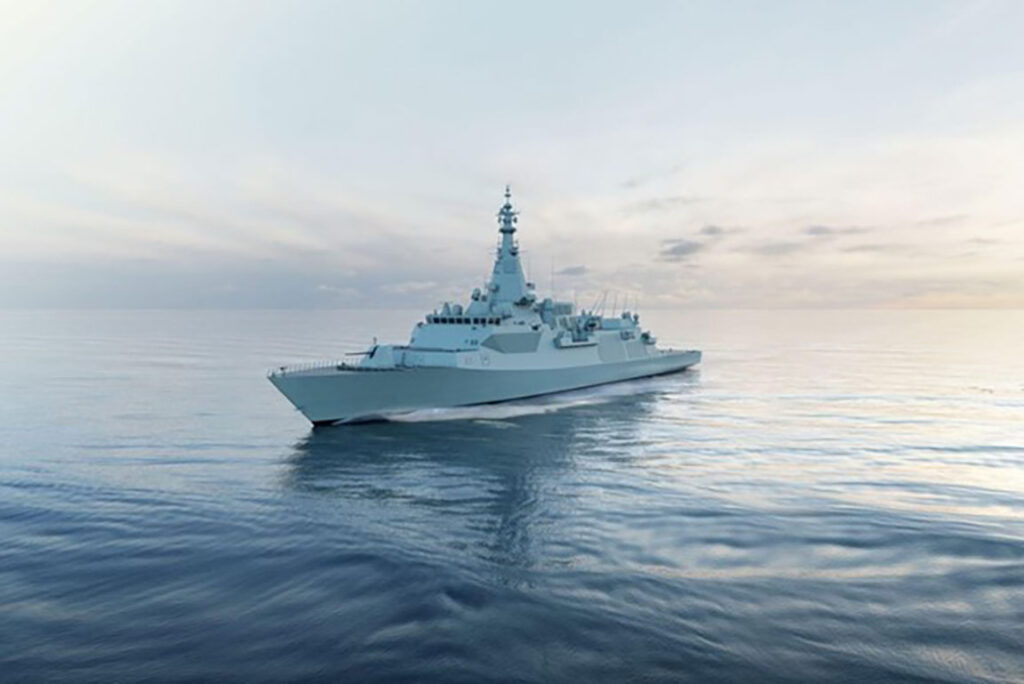Canada celebrated the beginning of construction for three River-class destroyers in June 2024 in Halifax. The new ships mark the start of a major overhaul for the Royal Canadian Navy. IRVING SHIPBUILDING INC. (Artist Rendering)
THE WATCH STAFF
Canada’s top naval and defense officials gathered in Halifax, Nova Scotia, in June 2024 to mark the beginning of construction of three new Royal Canadian Navy (RCN) warships. The three Canadian Surface Combatant (CSC) ships will be the first of what will be known as River-class destroyers and will be named His Majesty’s Canadian Ships (HMCS) Fraser, Saint-Laurent and Mackenzie. The ships are the cornerstone of Canada’s naval regeneration plan as it seeks to increase its naval capabilities to better meet its NATO obligations and to defend its vast Arctic territories. “The River-class will be Canada’s major component of maritime combat power, enabling us to continue to monitor and defend our own coastal waters, and contribute significantly to international naval operations alongside our Allies,” stated a Canadian defense ministry news release.
The CSC project marks a major overhaul of Canada’s naval fleet with production in Halifax naval yards ramping up to full speed in 2025. Delivery of the first River-class destroyer, HMCS Fraser, is expected in the early 2030s, with the final ship in the CSC class expected by 2050, the release stated. The project will create nearly 11,000 jobs through the 25-year construction phase and generate $40 billion in cumulative gross domestic product (GDP). Minister of National Defence Bill Blair said the historic investment will pay off in strengthening Canadian and North American security.
“Today, we launch construction on the largest Canadian shipbuilding project since the Second World War, marking an historic milestone for the Royal Canadian Navy. The River-class destroyers will provide the Canadian Armed Forces with the tools that they need to defend our national interests for decades to come — and ensure that Canada can deploy a state-of-the-art, combat-ready fleet of warships to defend our country and support our allies. As we invest in this new fleet, we are also supporting Canada’s shipbuilding industry and thousands of well-paying, skilled jobs. Bravo Zulu to everyone who has helped us reach this important day,” Blair said at the June 28 ceremony.
The River-class ships are based on British multinational defense company BAE Systems’ Type 26 warship design being built by the United Kingdom and Australia. The ships will have enhanced underwater sensors, state-of-the-art radar and modern weapons, the release stated. The NATO-designated ships will be classified as DDGH— a guided-missile, helicopter-capable destroyer. River-class ships will replace aging Iroquois-class destroyers and Halifax-class frigates, according to the government. The River-class are fast, maneuverable, anti-aircraft and anti-submarine long-distance warships, and capable of fleet escort and convoy duties or as part of a carrier-group fleet, the release stated. River-class destroyers — 151-meters long with a cruising range of 11,000 kilometers — will have a top speed of 27 knots and a maximum crew of 210, according to a Canadian government fact sheet.
The first three River-class ships’ names were chosen to reflect Canadian maritime history and the RCN. Before and during World War II, the RCN had more than a dozen River-class naval vessels of varying types. Several were lost in battle during the war.
“Not only are these three ships named after Canada’s most important waterways that reach the Pacific, Atlantic and Arctic oceans, they are also a tribute to previous Canadian warships with the same names — ships that made heroic wartime contributions and represented cutting-edge technological innovation. The RCN intends to foster a sense of pride in our sailors by connecting these ships to Canada’s maritime heritage,” the release stated.

